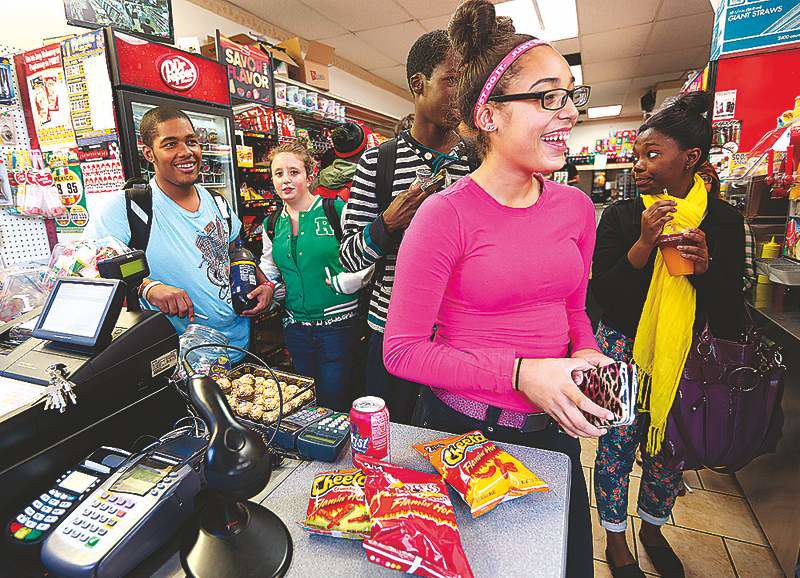Emotions run hot over Cheetos
Published 5:00 am Thursday, October 18, 2012

- Zian Garcia, 15, purchases a variety of Flamin' Hot flavored snacks at Touchdown Food Mart in Chicago. “Once you start eating them, they are kind of addicting,” Zian said.
CHICAGO — On a recent sunny fall afternoon, students from Lake View High School streamed out of a nearby convenience store munching after-school snacks.
Some bought cookies and snack cakes. Others got soft drinks and candy. But the majority walked out of Touchdown Food Mart with crinkly orange bags of Flamin’ Hot Cheetos — sometimes with warm cheese sauce poured on top of the fiery red curls.
“Once you start eating them, they are kind of addicting, and you can’t help it,” said sophomore Zian Garcia. “Personally I have been eating them for years, and I cannot stop. I just have this urge to eat them.”
In the 20 years since Frito-Lay launched Flamin’ Hot Cheetos as a snack aimed at urban convenience stores, the product has inspired dozens of spicy competitors, multiple Facebook fan pages, a viral rap video and legions of loyal young fans.
But for many school administrators and public health advocates, the wild popularity of Flamin’ Hots inspires concern. To many, they’ve become shorthand for everything that is wrong with the diets of American children, whose obesity rates have tripled since 1980.
While it’s true that Flamin’ Hots, also known as Hot Cheetos, deliver high levels of salt, fat and artificial colors with little nutrition or fiber in return, the same can be said for similar snacks.
Yet there is something about Flamin’ Hot Cheetos that inflames critics in a way that other snacks — including regular Cheetos — never did. Some schools and districts, including Illinois’ Noble Street Charter School Network and the entire Rockford school district, have banned Flamin’ Hots by name, citing nutritional concerns.
“We don’t allow candy, and we don’t allow Hot Cheetos,” said Rita Exposito, principal of Jackson Elementary School in Pasadena, Calif. “We don’t encourage other chips, but if we see Hot Cheetos, we confiscate them — sometimes after the child has already eaten most of them. It’s mostly about the lack of nutrition.”
Is it an addiction?
It’s not hard to find kids who say they eat Flamin’ Hots or similar products every day, sometimes even for breakfast. If that sounds like an addiction, some scientists say it may not be far from the truth.
Emerging research on food addiction suggests that processed salty, fatty or sweet foods of any kind — also called “hyperpalatable foods” — can trigger brain responses similar to those created by controlled substances in addicted individuals.
People react differently to a processed food than they do to foods found whole in nature, said Ashley Gearhardt, an assistant professor of clinical psychology at the University of Michigan.
“It’s something that has been engineered so that it is fattier and saltier and more novel to the point where our body, brain and pleasure centers react to it more strongly than if we were eating, say, a handful of nuts,” Gearhardt said. “Going along with that, we are seeing those classic signs of addiction, the cravings and loss of control and preoccupation with it.”
How popular are Flamin’ Hots across the country? It’s hard to say exactly. Market research data from Symphony IRI, which collects product scans from major retail stores excluding Wal-Mart, suggest potato chips are still the No. 1 salty snack food sold in American stores. The data also show that another Frito-Lay product, Doritos, sells more units than Cheetos. But the figures aren’t broken down by flavor or demographics.
Frito-Lay will not share sales figures for its products or comment on criticisms of Flamin’ Hots, but it does confirm that the flavor was introduced in the early ‘90s (some accounts say 1991; others 1992) to target “convenience stores in urban markets.” Today the company’s Flamin’ Hot line — including Flamin’ Hot Fritos, Flamin’ Hot Fries and XXTra Flamin’ Hot Cheetos — has spread to include at least 10 other snacks.
“There has been a lot of growth in ethnic-inspired flavors, and you can see it with many more bold and spicy flavor products across the salty snack category,” said Chris Clark, vice president of the Snack Food Association.
A spokeswoman for 7-Eleven stores said the fever for Flamin’ Hots has spread well beyond the urban market and is strongest among 14- to 24-year-olds.
“Flamin’ Hot Cheetos was a groundbreaking flavor profile when it was originally introduced,” Margaret Chabris said. “The ‘hot’ flavor profile continues to be a top performer for 7-Eleven stores but has broadened to include both urban and nonurban areas.”
Many spicy snacks have emerged to challenge Flamin’ Hots over the years, including Hot Thang Crunchy Nuggets, Hot ‘N Spicy Crunchy Nuggets, Sizzlin’ Hot Crunchy Kurls and Sizzlin’ Cheese Flavored Twists. But in the city’s corner stores, Flamin’ Hot Cheetos still reign supreme, owners say.
“It’s my No. 1 seller,” said Ali Bawazir, who owns Touchdown Food Mart in Chicago’s Lakeview neighborhood. “Kids get ‘em for breakfast too. They’re crazy about them.”
Red flags
Some parents may not realize how often their children are eating Flamin’ Hots until they wind up taking the kids to the doctor over “concern for blood in their stool,” according to Dr. Kathleen Berchelmann, a pediatrician at St. Louis Children’s Hospital.
Though parents may have a scare over the false alarm — caused by red food dye — Berchelmann said it also offers a great opportunity for a lesson on gluttony and moderation.
“When you eat something that sends you to the ER with your parents,” she said, “that’s not something you forget.”






